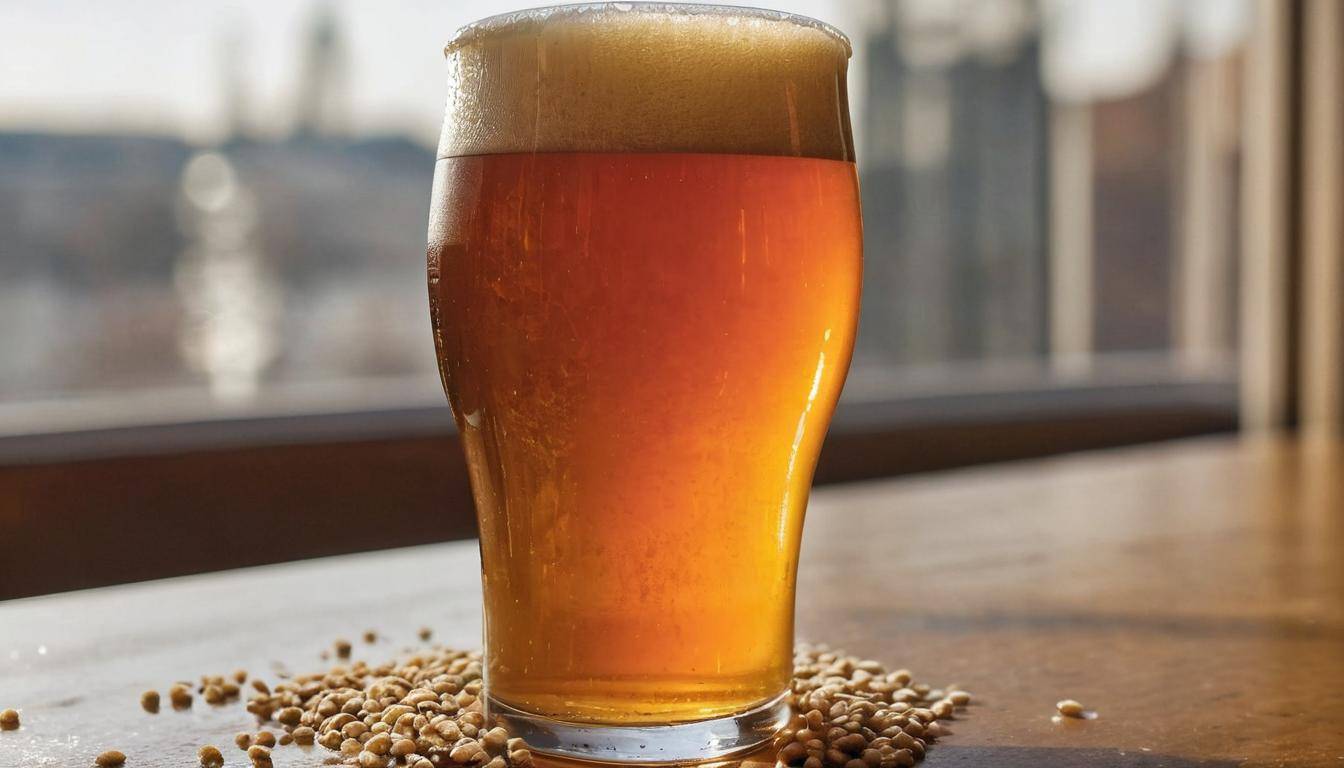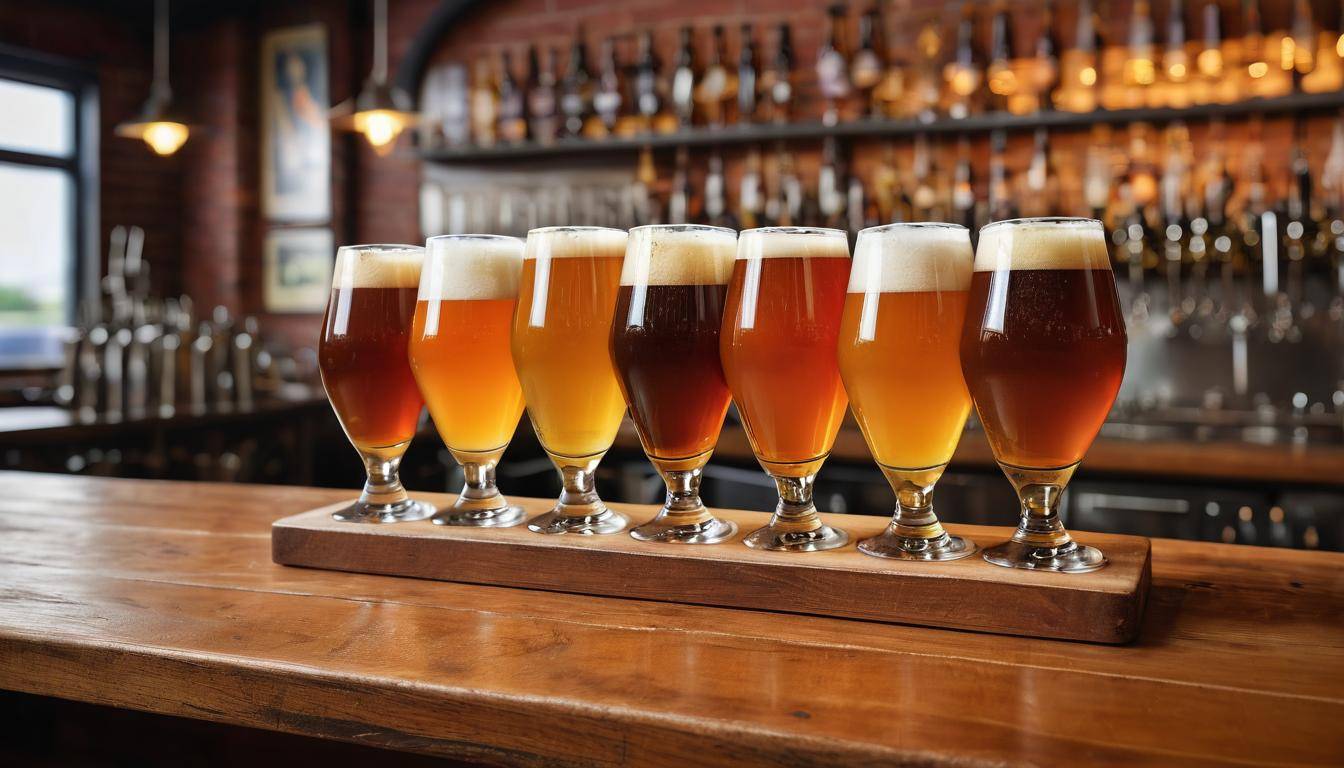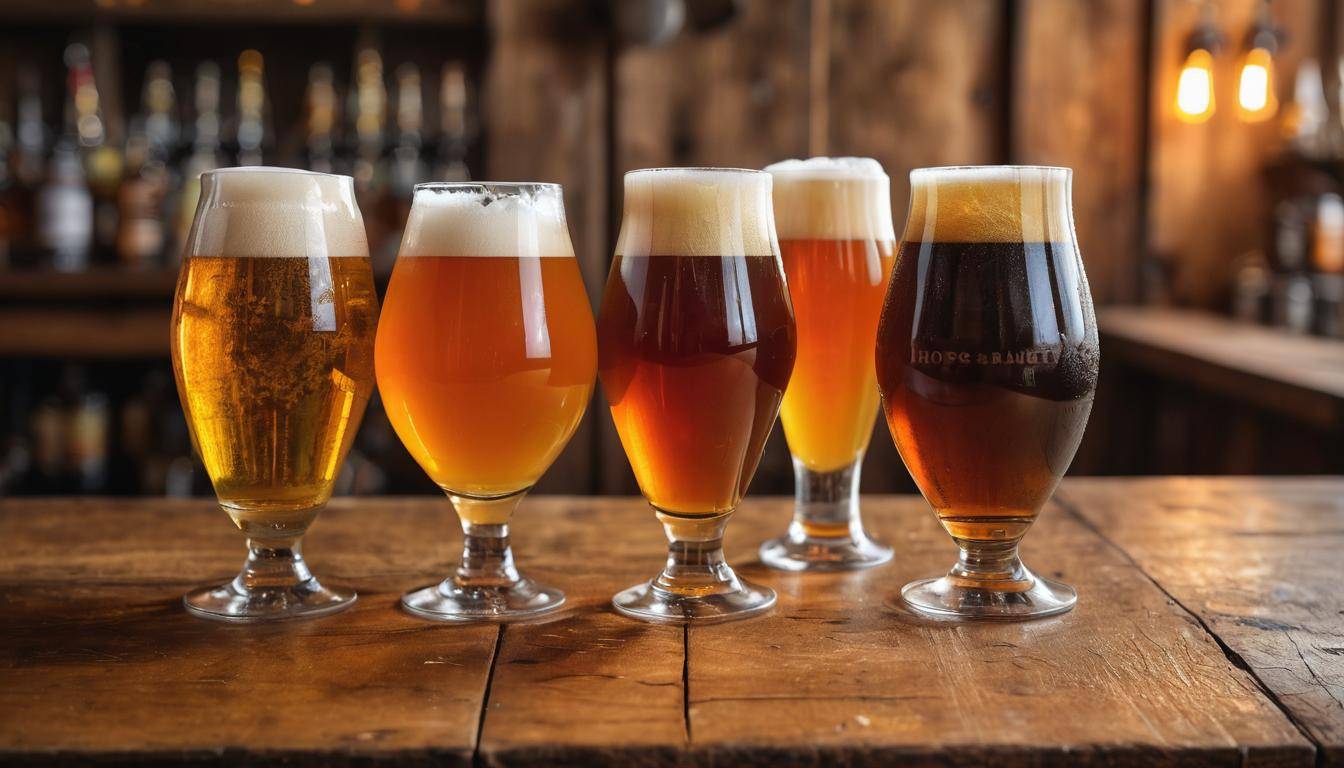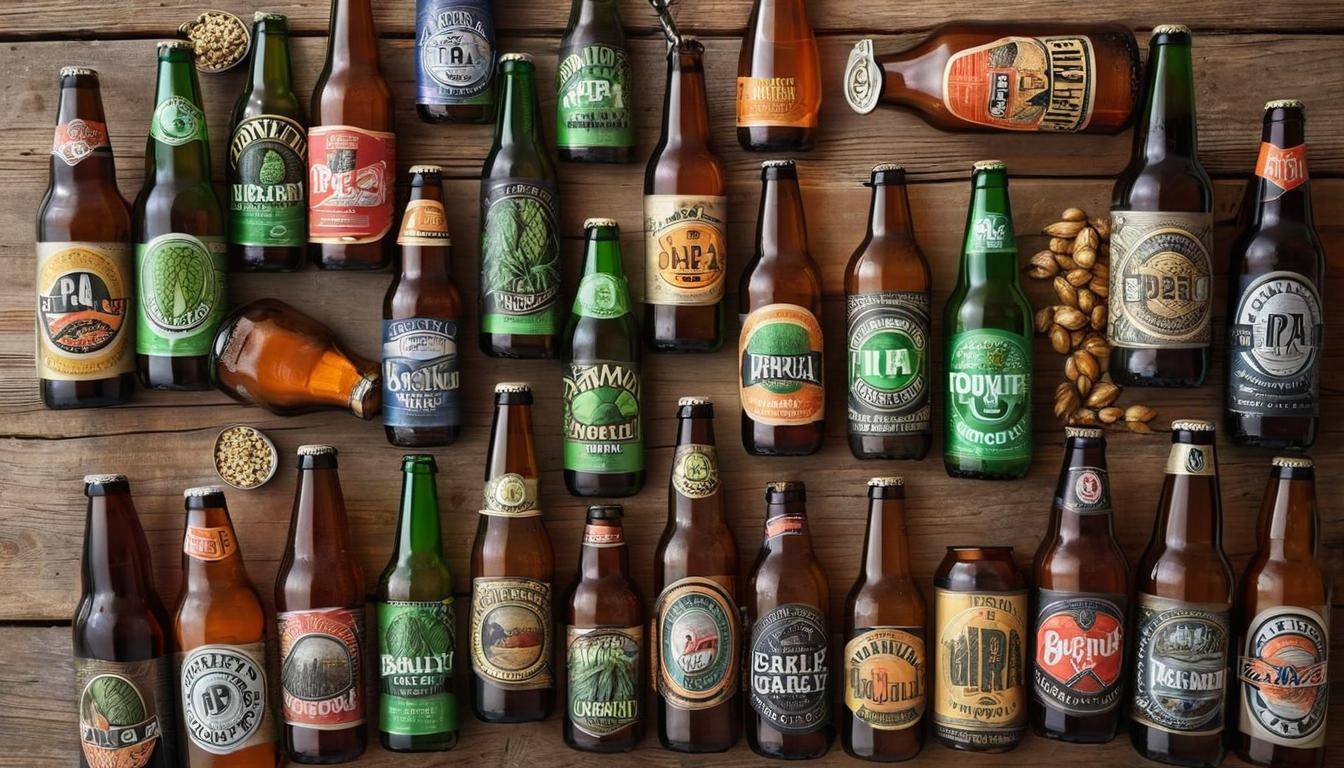
IPA, or India Pale Ale, is a hoppy beer style that originated in England during the 18th century, specifically brewed for export to India. Characterized by its higher hop content and distinct flavors, IPAs typically offer a bold and aromatic profile, making them one of the most popular styles in the craft beer industry today. Among other types, the DIPA stands out with its intensified hop presence.
The Origin of IPA Beer
The roots of India Pale Ale (IPA) reach back to the 18th century when British colonialism played a pivotal role in shaping brewing traditions. This period was marked by long voyages faced by merchants transporting goods to distant lands, particularly India. To ensure beer could survive these extensive trips without spoiling, brewers turned to hops—a natural preservative with robust flavor and aroma profiles. By increasing the hop content, they crafted a beverage that would endure the harsh conditions of sea travel while maintaining its taste and integrity over time.
As the popularity of this hoppy delight ascended, it became a status symbol among British expatriates and traders in India. Early pioneers included brewers like George Hodgson, who began producing his unique version around 1835 at Bow Brewery. His IPA quickly gained traction among East India Company traders who sought high-quality products for their lengthy stays abroad. The pricing of Hodgson’s Pale Ale was comparable to premium options like Guinness Double Stout, positioning it as a luxury good that appealed to discerning palates.
The term “India Pale Ale” is believed to have emerged during this time, encapsulating both its geographical association and its distinctiveness within the broader category of pale ales. Many enthusiasts regard this rich history as foundational for understanding the various styles and flavor profiles of IPAs available today, including those more potent versions like DIPAs.
The journey from Hodgson’s Bow Brewery to the modern craft beer movement illustrates how far this remarkable beer has come—it’s now enjoyed by millions around the world, transcending borders and cultures.
Even more intriguing is how IPA evolved over time, giving rise to numerous sub-styles that cater to diverse tastes—from West Coast IPAs with bold hoppy notes to New England IPAs known for their hazy appearances and juicy flavors. Each iteration retains a connection to that daring spirit of exploration and ingenuity from centuries past; it embodies the blend of tradition and innovation in today’s craft beer scene.
Understanding these historical contexts not only enriches your appreciation for this iconic beer style but also leads you into a world of intriguing variations waiting to be explored further.
Different Styles of IPA Beer

The landscape of India Pale Ales (IPAs) is as diverse as the regions from which they originate. Whether you prefer a classic IPA or the stronger, hop-heavy DIPA, each type offers a unique tasting adventure.Each style captures a different essence and showcases various aspects of hop characteristics, appealing to a wide range of preferences among beer enthusiasts. The craft beer revolution has truly expanded the horizons for beer lovers, introducing them to an array of delightful brews that can be enjoyed in the comfort of a local pub or savored in an elegant glass at home.
West Coast IPA
Take the West Coast IPA, for instance. Renowned for its strong hoppy presence, this style is a bold statement in any beer lover’s collection. A typical West Coast IPA flaunts a well-defined bitterness level, often characterized by piney and citrusy notes that make each sip invigorating. The slightly higher IBU values—often ranging from 50 to 100—give these IPAs their signature crispness and clean finish. It’s like stepping out into a sun-drenched forest; the bracing pine aroma wraps around you while the zestiness dances on your palate. Enjoying a West Coast IPA from a well-chosen glass can elevate the tasting experience.
Now, let’s shift our focus to another beloved style that has captured the hearts of many craft beer drinkers.
New England IPA (NEIPA)
Enter the New England IPA, often affectionately referred to as NEIPA. This hazy variant stands in stark contrast to its West Coast sibling. When you pour a NEIPA, you’re greeted with a beautiful cloudiness that hints at its juicy character. The flavors here are vibrant and inviting, typically bursting with tropical fruits like mango, pineapple, and citrus. One might liken sipping on a NEIPA to indulging in a freshly blended fruity smoothie—the smooth expansion of flavors coats your mouth, leaving behind just enough sweetness without an overpowering bitterness. Generally lower in IBU (around 30-50), NEIPAs prioritize flavor over sheer bitterness, offering a softer and creamier mouthfeel.
After exploring these two thrilling styles, it’s important to mention an option designed for those who enjoy savoring multiple draft brews without feeling weighed down.
Session IPA
Introducing the Session IPA—a delightful choice for long gatherings or lazy afternoons at a favorite pub. Usually clocking in at an ABV under 5%, Session IPAs strike a remarkable balance between accessibility and flavor intensity. Picture this: you’re out with friends on a warm summer’s day; perhaps you’ve been hopping from one social event to another. A Session IPA allows you to remain part of the celebration while delivering the hop-forward profile characteristic of traditional IPAs. It tempts your taste buds with bright hop flavors but keeps it all gentle on the alcohol content.
- West Coast IPA: High bitterness level, boldly piney and citrusy.
- New England IPA: Beautifully hazy, juicy with tropical notes and lower bitterness.
- Session IPA: Lower ABV allows for extended enjoyment while maintaining noticeable hop flavors.
For those who crave an even more robust experience, the Imperial IPA steps in as a powerhouse within the craft beer revolution. With a higher alcohol content and intense hop flavors, this style is perfect for seasoned palate explorers, offering complexity and depth in every sip. Whether sipped in a traditional pub setting or from a specially crafted glass, the Imperial IPA never fails to impress.
Key Ingredients in IPA

Each style of IPA holds its unique charm and complexities that make them treasures among enthusiasts everywhere. This exploration naturally leads us to consider what builds these beloved beers and how they contribute to crafting distinctive experiences in every sip.
Hops in IPAs
The magic of IPA lies in its ingredients, each contributing uniquely to its iconic flavor. Without a solid grasp of these components, one might miss the complexity that makes IPAs so enjoyable.
Hops are the defining ingredient, providing both bitterness and aromatic qualities that distinguish IPAs from other beer styles. Common hop varieties like Citra, Amarillo, and Cascade not only add a refreshing zing but also impart distinct notes ranging from floral and citrusy to earthy and piney. This diversity allows brewers to experiment endlessly; a hop-forward IPA can deliver a burst of tropical fruit flavors while another may evoke the essence of a spring meadow. Each hop variety brings unique complexities, enhancing your tasting experience.
Malt For Brewing
While hops fire up the palate, other ingredients like wheat can balance their boldness and contribute depth in flavor and texture, a technique often utilized by craft brewers who are continuously innovating with traditional recipes.
Malts play an essential role by balancing the hop bitterness with sweetness. They come from roasted grains, significantly influencing both color and body. For example, pale malts are typically used as a base malt due to their lighter color and mild flavor, allowing the hop character to shine through. However, adding caramel malts can impart additional richness and sweetness, creating a smoother mouthfeel that contrasts nicely with the hops’ sharp edges. This interplay between malt and hops is vital; without it, an IPA could become overwhelmingly bitter or too sweet.
Water For Beer
Next up is an often overlooked but incredibly important part of the brewing process: water.
The water chemistry can significantly affect the final product, influencing everything from mouthfeel to how hops behave during brewing. The mineral content in water—namely sulfate and chloride—can enhance or soften hop bitterness. Higher sulfate levels often accentuate hop flavor, giving the beer a crisp finish, while increased chloride can lend a smoother, more rounded mouthfeel. Brewers meticulously formulate their water profiles to optimize the characteristics of their chosen hops and malts during fermentation.
Yeast Fermenting Beer
Finally, we have yeast—the unsung hero that unleashes the full potential of these ingredients.
Yeasts are responsible for fermenting sugars found in malt into alcohol while delivering additional flavors through metabolic processes. For most IPAs, ale yeast is commonly employed; this strain ferments at warmer temperatures than lager yeast, resulting in cleaner flavors with slight fruity notes that complement the hoppy profile. The choice of yeast profoundly impacts an IPA’s overall character—from enhancing aroma to modifying mouthfeel—making it essential for any brewer aiming to perfect their recipe.
Each ingredient, including wheat, plays a critical role within IPAs, weaving together flavors we love in this exceptional beer style. Understanding how they interact provides valuable insight for homebrewers and enthusiastic tasters alike.
IPA Flavor Profiles

As we explore further, let’s look into the intricate flavor profiles that emerge from these carefully selected ingredients, often crafted by esteemed craft brewers who blend tradition with innovation.
Understanding the flavor profiles of IPAs can significantly enhance your beer-drinking experience.
The first aspect to consider is bitterness. This quality is measured in International Bitterness Units (IBU), typically ranging from 40 to 70 for most IPAs. However, some bold varieties can exceed 100 IBUs. For many enthusiasts, this bitterness plays a crucial role in creating balance. The hops’ sharpness often meets the sweetness of malts, resulting in a pleasing harmony on the palate.
Fruity Notes
Thus, when sipping on an IPA, pay attention to how the bitterness unfolds and what role the malt plays to either elevate or soften that bite.
Another defining feature of IPA flavor profiles involves fruity notes. Derived from different hop varieties—like Citra or Mosaic—these flavors can range widely. Imagine taking a sip and feeling as if you’re biting into a ripe grapefruit or enjoying a splash of tropical fruits like mango and pineapple. This characteristic is particularly pronounced in New England IPAs, which tend to deliver a juicy experience often compared to fresh-squeezed juice. The mouthfeel enhances this fruity sensation, making each sip vibrant and refreshing. The gentle carbonation in many of these brews adds an extra layer of effervescence, turning each tasting experience into a lively event.
Herbaceous Qualities
What makes these fruity notes so appealing is their versatility. Each brewer can select specific hop combinations to craft unique profiles that cater to a myriad of tastes. Imagine enjoying a pint of IPA with carefully selected hops that accentuate those fruit-forward characteristics.
Lastly, we cannot overlook the herbaceous qualities that some IPAs bring to the table. These aromas can include earthy, piney, or even herbal notes that add layers of complexity. West Coast IPAs frequently showcase this characteristic, with their strong emphasis on pine and resin flavors reminiscent of a walk through a dense forest. A fantastic example would be brews using Simcoe or Chinook hops; they can transport your senses deeper into nature while sipping.
Not only do these herbaceous elements enhance the depth of flavor, but they also influence your overall tasting experience by bringing forth nostalgic sensations rooted in nature. Enjoying these flavors in a pint of IPA truly immerses the drinker in an aromatic experience.
IPA’s Role in Craft Brewing

With an understanding of these key components—bitterness, fruity notes, and herbaceous qualities—you are now prepared to explore further aspects of this remarkable beverage category that highlight its role within the craft brewing movement. The subtle influence of carbonation helps elevate the tasting experience, making each sip both refreshing and memorable.
Driving Innovation
Within the vibrant world of craft brewing, IPAs represent a cornerstone that reflects both creativity and consumer taste. Their distinct flavors and varied profiles not only satisfy individual palates but also push brewers to innovate continually. When craft breweries gained traction in the late 20th century, IPAs emerged as the flagship offering for many. This was no mere coincidence; the unique characteristics of IPAs resonated powerfully with consumers eager for something beyond mass-produced lagers.
The explosion of craft beer led to an impressive surge in IPA production, where brewers embraced adventurous spirits and sought to redefine conventional beer styles. In their quest for uniqueness, they experimented with diverse hop varieties, introducing new flavors and aromas that had never been experienced before.
Cultural Significance
Imagine tasting a beer infused with tropical fruit notes or having a hint of pine or floral essence—a sensory delight that keeps beer enthusiasts coming back for more. These innovations have led to hybrid styles, such as New England IPAs, which favor hazy appearances and juicy flavors over traditional bitterness. The emphasis on experimentation has not only expanded the boundaries of what an IPA can be but has also fostered a culture of collaboration among brewers, who often share their findings and techniques.
Battle Horn Brewing’s Unique Contribution
Beyond its flavor profile, the cultural impact of IPAs is profound. These beers have carved out significant space in festivals around the globe, with events dedicated entirely to celebrating this versatile style. Consider gatherings like the Great American Beer Festival, where numerous categories spotlight IPAs; it’s a testament to their popularity and significance. Similarly, dedicated days like IPA Day draw attention to this robust brew, allowing craft beer lovers to connect over shared passions while discovering new favorites. Community involvement is essential here, as many craft breweries host or participate in these events, fostering camaraderie amongst fans and brewers alike. Enjoying a crisp pint during these occasions is as much about the communal experience as the beer itself. At Battle Horn Brewing, we take inspiration from this thriving culture by crafting a diverse range of IPAs that reflect both innovative approaches and classic traditions. Our commitment to quality ensures that every sip delivers an experience worth savoring.
As we explore the craftsmanship behind these beloved brews, let’s also consider some notable examples that showcase the variety and creativity within the IPA category.
Popular IPA Brands

Several brands have become synonymous with exceptional IPA production, each contributing its unique flair to the craft beer scene. This landscape is not just about high alcohol content; it’s about the artistry behind the hops and how different breweries interpret this beloved style. Notable names that have truly made their mark include BrewDog, Sierra Nevada, and, of course, Battle Horn Brewing.
BrewDog
Known for their flagship Punk IPA, BrewDog has set a high standard in Europe while expanding their influence globally. Their commitment to pushing boundaries in brewing can be seen not only in their flavor profiles but also in their bold branding and business approach. They often take risks with hop varieties, creating IPAs that range from intensely bitter to explosively fruity.
I remember walking into a bar that served exclusive BrewDog lines; the excitement among patrons was palpable as they discussed which new creations to try. This brand doesn’t just brew beer; they create experiences that keep enthusiasts coming back for more.
Sierra Nevada
Celebrated for the iconic Torpedo Extra IPA, Sierra Nevada has been a pioneer in bringing hop-forward beers to mainstream audiences since 1980. Their meticulous approach to sourcing the freshest ingredients allows them to capture distinct flavors that resonate well with both conventional beer drinkers and hop-lovers alike.
The use of whole-cone hops infuses their brews with exceptionally detailed flavors. I recall my first sip of a Torpedo; the burst of citrusy notes followed by a resinous finish was a revelation. It’s no surprise that this brewery has paved the way for others by laying down a framework of quality and consistency within the craft beer industry.
Battle Horn Brewing
At our own brewery, we pride ourselves on offering a curated selection of IPAs made with high-quality ingredients and pioneering brewing techniques. Each batch is crafted with care to ensure that we deliver both complexity and drinkability, capturing the spirit of what an IPA should embody. Whether you’re looking for something bold or crisp, we aim to satisfy diverse palates while showcasing the artistry involved in crafting each brew.
Understanding these key players not only enriches your appreciation for IPAs but also lays the groundwork for exploring the exciting innovations being developed across the craft beer spectrum.
In summary, each of these brands represents a unique perspective on what IPAs can be, highlighting the creativity and passion that define this vibrant segment of craft beverages.
